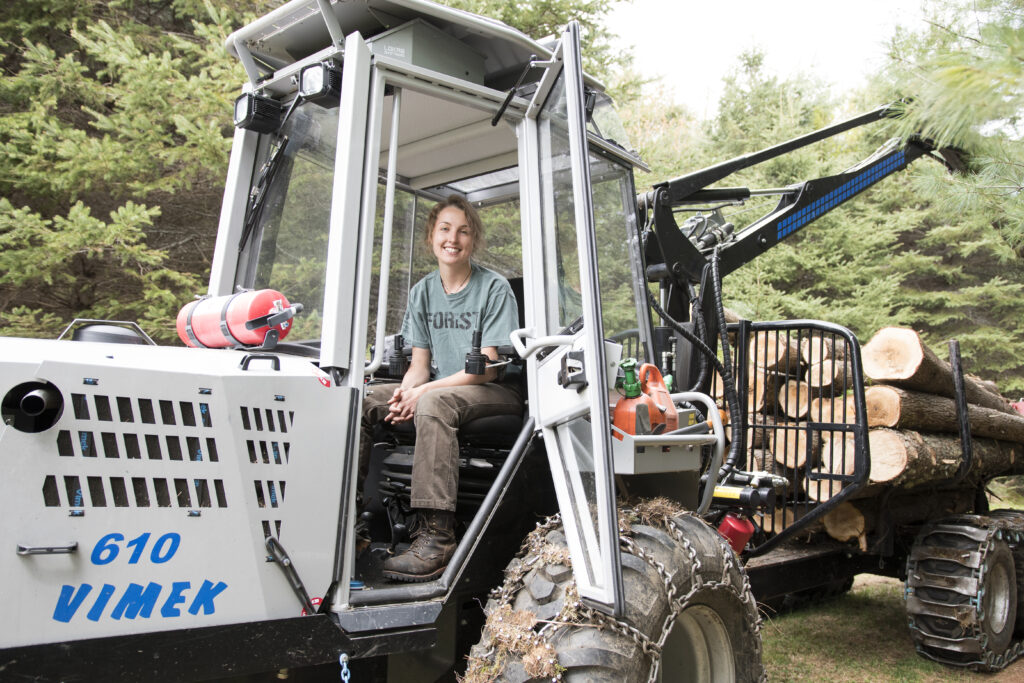Curious about a career in the forest economy?
Do you love to work outdoors? Enjoy making things with your hands? Love to drive big machines? A career in Vermont’s forest economy could be a great fit for you!

“The next generation of forest economy professionals will steward Vermont’s most valued natural resource for both economic and environmental benefit,” said Christine McGowan, forest program director at the Vermont Sustainable Jobs Fund. “As the current workforce ages and approaches retirement and new technologies and markets appear, there are opportunities for both employment and advancement in all areas of the industry.”
With over 20,000 forest related jobs in Vermont, there is a need for all skill sets within the industry.
Primary careers
Many jobs within the forest economy involve working directly with nature. These are referred to as “primary careers,” and they often look like what may come to mind when you think about forestry. Forestry careers in the primary sector are responsible for the management and stewardship of Vermont’s forests. A primary career in the forestry industry is a great option if you like being outdoors and want a hands-on job.
For example, someone who likes cars and driving would be a good fit as a heavy and tractor-trailer driver. This job includes safely transporting on firm deadlines thousands of pounds of lumber, other natural materials and machinery to and from worksites. Drivers are in high demand with 439 job openings in this field each year and an hourly wage of around $23. A Commercial Drivers License is required to drive heavy trucks, but training programs usually only take about 12 weeks to complete. A Career and Technical Education (CTE) Center near you likely has a training program you can enroll in.

If you enjoy maps and data, the need for geographic information system (GIS) technicians is expected to rise in the near future. GIS technicians work with technology to aid foresters and government in decision making and planning. Cartographers and photogrammetrists do similar work, but with a focus on mapmaking and visual data. These careers often require a bachelor’s degree, though a certificate or associate degree may gain access to some entry-level jobs. GIS technicians make about $33 an hour while cartographers and photogrammetrists make $36 an hour.
Loggers and fallers are responsible for safely cutting trees in a way that minimizes damage to the tree. Earning a median pay rate of $22 per hour, they work with foresters and landowners to harvest timber in line with a forest management plan. Entry level jobs require a high school diploma or similar level of education with on the job training. Logging certifications can be found at many career and technical centers in the state.
Secondary careers
The secondary sector works with the forest materials gathered by the primary sector and turns them into products for the public to use. These career paths may work well for creatives and those who enjoy working with their hands.

Carpenters, for example, have more than 400 projected job openings in Vermont and are paid an hourly wage of $23. Training typically involves three to twelve months on-the-job. Employers look for attention to detail, familiarity with hand and power tools, basic math skills, and excellent communication.
If you enjoy crafting more specific products, there are about 75 annual job openings for cabinetmakers and bench carpenters. These workers earn an hourly wage of $18. The carpentry field demands creativity and precision, and there are many different career paths within the industry.
Someone who is more interested in design might like a career as an architectural and civil drafter. This profession has a median hourly pay of $29 and you can enter this field with an associate degree. Architectural and civil drafters work hand in hand with civil engineers, a career that requires a bachelor’s degree and pays a median wage of $37 an hour. Both professions require knowledge of engineering, building technology, and the principles of construction.

Related Careers
There are many other professions that are part of the forestry industry but do not involve working outdoors or with forest resources. Some of these jobs take place at businesses that are directly involved with the forest. Others overlap with different career paths, from education to business to law.
Someone with excellent social skills may be drawn to a sales representative position that pays about $29 an hour. This high pay, high demand job is estimated to have over 200 job openings in Vermont each year. Sales representatives sell products from manufacturers and wholesalers to customers. Entry level jobs usually require short training programs after high school.
Accounting is a highly sought after job, with an hourly wage of $33. Annually, there are around 300 jobs available in accounting. With so many businesses along the supply chain, there is a need for the administrative support and financial advice that accountants offer. A certificate gains entry into the field as a bookkeeper, though a bachelor’s degree is needed to become a certified public accountant.
The importance of environmental law continues to climb as the climate crisis evolves, and paralegals are in high demand. Paralegals assist lawyers in preparing for and researching their cases. The median hourly wage for this profession is $24. There are approximately 87 job openings in Vermont each year and an associate degree is required.
With forests covering over 78% of Vermont land, forest-related work has become a diverse and dynamic field. Each of these careers, and many others, are an important part of Vermont’s forest economy. For more information on these career paths visit the Vermont Sustainable Jobs Fund’s Forest Economy Workforce webpage or click here to download its Vermont Forest Economy Career Guide.





